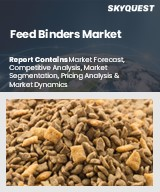
|
시장보고서
상품코드
1518498
세계의 사료 결합제 시장 : 공급원별, 유형별, 가축별, 지역별 분석 및 예측(2024-2032)Feed Binders Market - By Source (Natural, Synthetic), By Type (Lignosulfonates, Plant gums & starches, Gelatin, Molasses, Clays), By Livestock (Poultry, Aquaculture, Swine, Pet), Regional Analysis and Forecast 2024 - 2032 |
||||||
세계 사료 결합제 시장 규모는 가축 생산 수요 증가로 인해 2024-2032년간 5.3% 이상의 CAGR을 나타낼 것으로 예상됩니다.
이러한 첨가제는 펠렛을 형성하고 가축의 영양 흡수와 사료 효율을 높이고 사료의 품질을 향상시키는 데 필수적입니다.
지속가능한 축산 강화를 지원하기 위해 소화율을 높이고 환경에 미치는 영향을 줄이는 새로운 결합제 등의 개발로 사료 성능이 최적화되어 효율적인 축산에 의존하는 세계 인구 증가에 따른 영양 요구를 충족시킬 수 있게 되었습니다. 인베스트 인디아(Invest India) 보고서에 따르면, 2022-23년 인도의 총 계란 생산량은 1,383억 8,800만 개에 달할 것으로 예상됩니다. 이러한 성장은 가축의 영양과 생산성 향상에 있어 사료 결합제의 중요한 역할을 더욱 강조하고 있습니다.
산업은 공급원, 유형, 가축, 지역으로 구분됩니다.
젤라틴 유형 사료 바인더 시장 규모는 2024-2032년 동안 양호한 성장률을 나타낼 것으로 예상됩니다. 젤라틴은 사료 효율과 펠렛의 품질을 향상시키기 위해 가축 영양학에서 사료 바인더로 사용됩니다. 개량된 젤라틴 유도체와 같은 발전은 영양 흡수를 최적화하고 지속 가능한 농법을 지원하는 데 도움이 되고 있습니다. 가축의 건강과 생산성을 향상시키기 위해 효과적이고 균형 잡힌 영양을 섭취할 수 있도록 하기 위함입니다.
가축의 경우, 가금류 부문의 사료 배합사료 시장은 2024-2032년 사이 높은 CAGR을 나타낼 것으로 예상됩니다. 이는 가금류 사육에서 혼합 사료의 영양가와 일관성을 향상시킬 필요가 있기 때문입니다. 사료 바인더는 가금류의 소화율과 전반적인 건강 상태를 개선하기 위해 영양소가 효과적으로 부착되도록 합니다. 이러한 바인더는 더 엄격한 규제 기준을 충족하기 위해 진화하고 있으며, 사료 효율을 최적화하고 환경에 미치는 영향을 최소화하기 위해 배합 기술도 발전하고 있습니다.
유럽의 사료 결합제 산업은 소비자의 인식 향상으로 인한 사료 분야의 성장으로 인해 2032년까지 상당한 CAGR을 나타낼 것으로 예상됩니다. 이러한 확대는 보다 고품질의 지속 가능한 사료 솔루션에 대한 수요에 대응하는 데 도움이 되고 있습니다. 소비자의 인식이 높아짐에 따라 엄격한 품질 및 환경 기준을 충족하는 사료 첨가제에 대한 요구가 증가하고 있습니다. 유럽의 가금류 및 축산 분야에서는 영양가와 안전성을 높이기 위한 사료 첨가제 기술 혁신이 계속되고 있으며, 이는 시장 성장의 원동력이 되고 있습니다.
목차
제1장 조사 방법과 조사 범위
제2장 주요 요약
제3장 업계 인사이트
- 생태계 분석
- 원재료 공급업체
- 제조업체
- 이익률 분석
- 유통 채널 분석
- 용도
- 벤더 매트릭스
- 주요 원재료 공급업체 리스트
- 주요 제조업체/공급업체 리스트
- 기술 상황
- 규제 상황
- 영향요인
- 성장 촉진요인
- 업계의 잠재적 리스크와 과제
- 가격 분석
- 지역 가격 결정
- 비용 구조 분석
- 연구개발 비용
- 제조 및 설비 비용
- 원재료 비용
- 유통 비용
- 운영 비용
- 잡비
- 혁신과 지속가능성
- 잠재 성장력 분석(2023년)
- Porter의 Five Forces 분석
- PESTEL 분석
제4장 경쟁 구도
- 서론
- 기업 점유율
- 지역별 점유율
- 주요 시장 기업의 경쟁 분석
- 경쟁 포지셔닝 매트릭스
- 전략적 전망 매트릭스
제5장 사료 결합제 세계 시장 추산·예측 : 공급원별(2018년-2032년)
- 주요 동향
- 천연
- 합성
제6장 사료 결합제 세계 시장 추산·예측 : 유형별(2018년-2032년)
- 주요 동향
- 리그노술폰산염
- 식물 껌 및 전분
- 젤라틴
- 당밀
- 점토
- 기타
제7장 사료 결합제 세계 시장 추산·예측 : 가축별(2018년-2032년)
- 주요 동향
- 가금 사료
- 수산양식
- 양돈
- 반려동물 사료
제8장 사료 결합제 세계 시장 추산·예측 : 지역별(2018년-2032년)
- 주요 동향 : 지역별
- 북미
- 미국
- 캐나다
- 유럽
- 독일
- 영국
- 프랑스
- 이탈리아
- 스페인
- 기타 유럽
- 아시아태평양
- 중국
- 인도
- 일본
- 한국
- 호주
- 기타 아시아태평양
- 라틴아메리카
- 브라질
- 멕시코
- 아르헨티나
- 기타 라틴아메리카
- 중동 및 아프리카
- 남아프리카공화국
- 사우디아라비아
- 아랍에미리트(UAE)
- 기타 중동 및 아프리카
제9장 기업 개요
- Adisseo
- ADM
- Alltech
- BASF SE
- Borregaard
- Cargill
- DSM
- DuPont
- Kemin Industries
- O K Bio Systems
- Visco Starch
Feed Binders Market size is set to record more than 5.3% CAGR from 2024 to 2032, owing to the increasing livestock production demands. These additives are essential for forming pellets and improving feed quality for enhancing nutrient absorption and feed efficiency in livestock.
Developments, such as novel binders that enhance digestibility and reduce environmental impacts for supporting sustainable intensification of livestock farming are optimizing feed performance and meeting the nutritional needs of the growing global population reliant on efficient animal agriculture. According to a report by Invest India, the country's total egg production reached 138.38 billion in 2022-23. This growth is further emphasizing the critical role of feed binders in enhancing livestock nutrition and productivity.
The industry is segmented into source, type, livestock, and region.
Feed binders market size from the gelatin type segment will record a decent growth rate between 2024 and 2032. Gelatin is used as a feed binder in livestock nutrition for improving feed efficiency and pellet quality. Increasing advancements, such as enhanced gelatin derivatives are helping in optimizing nutrient absorption and support sustainable farming practices. This ongoing development will underscore the importance of gelatin in modern agriculture for ensuring that the livestock receive effective and balanced nutrition for improved health and productivity.
In terms of livestock, the feed binders market from the poultry segment is anticipated to witness significant CAGR from 2024-2032. This is due to the need for enhancing the nutritional value and consistency of feed mixes in poultry farming. Feed binders ensure that nutrients adhere effectively for improving digestibility and the overall health of poultry. These binders are also evolving to meet the stricter regulatory standards and advancing in formulation techniques to optimize feed efficiency and minimize environmental impacts.
Europe feed binders industry size will record substantial CAGR through 2032 due to the growth in the feed sector, driven by increasing consumer awareness. This expansion is helping in addressing the demands for higher-quality and sustainable feed solutions. Consumer awareness is also fostering greater need for feed binders that meet stringent quality and environmental standards. The ongoing innovations in feed binder technologies for enhancing nutritional value and safety across the European poultry and livestock sectors will drive the market growth.
Table of Contents
Chapter 1 Methodology & Scope
- 1.1 Market scope & definition
- 1.2 Base estimates & calculations
- 1.3 Forecast calculation
- 1.4 Data sources
- 1.4.1 Primary
- 1.4.2 Data Mining sources
- 1.4.2.1 Paid sources
- 1.4.2.2 Public sources
Chapter 2 Executive Summary
- 2.1 Global feed binders market 360 degree synopsis, 2018 - 2032
- 2.2 Business trends
- 2.3 Regional trends
- 2.4 Source trends
- 2.5 Type trends
- 2.6 Livestock trends
Chapter 3 Industry Insights
- 3.1 Industry ecosystem analysis
- 3.1.1 Raw material suppliers
- 3.1.2 Manufacturers
- 3.1.3 Profit margin analysis
- 3.1.4 Distribution channel analysis
- 3.1.5 Application
- 3.2 Vendor matrix
- 3.2.1 List of key raw material suppliers
- 3.2.2 List of key manufacturers/suppliers
- 3.3 Technology landscape
- 3.4 Regulatory landscape
- 3.4.1 North America
- 3.4.2 Europe
- 3.4.3 Asia Pacific
- 3.4.4 Latin America
- 3.4.5 Middle East & Africa
- 3.5 Impact forces
- 3.5.1 Growth drivers
- 3.5.2 Industry pitfalls & challenges
- 3.6 Pricing analysis
- 3.7 Regional pricing
- 3.7.1 North America
- 3.7.2 Europe
- 3.7.3 Asia Pacific
- 3.7.4 Latin America
- 3.7.5 Middle East & Africa
- 3.8 Cost structure analysis
- 3.8.1 R&D cost
- 3.8.2 Manufacturing & equipment cost
- 3.8.3 Raw material cost
- 3.8.4 Distribution cost
- 3.8.5 Operating cost
- 3.8.6 Miscellaneous cost
- 3.9 Innovation & sustainability
- 3.10 Growth potential analysis, 2023
- 3.11 Porter's analysis
- 3.12 PESTEL analysis
Chapter 4 Competitive Landscape, 2023
- 4.1 Introduction
- 4.2 Company market share, 2023
- 4.2.1 Company market share, by region, 2023
- 4.2.1.1 North America
- 4.2.1.2 Europe
- 4.2.1.3 Asia Pacific
- 4.2.1.4 Latin America
- 4.2.1.5 Middle East & Africa
- 4.2.1 Company market share, by region, 2023
- 4.3 Competitive analysis of major market players
- 4.4 Competitive positioning matrix
- 4.5 Strategic outlook matrix
Chapter 5 Global Feed Binders Market Estimates & Forecast, By Source, 2018-2032 (USD Million) (Tons)
- 5.1 Key Trends
- 5.2 Natural
- 5.3 Synthetic
Chapter 6 Global Feed Binders Market Estimates & Forecast, By Type, 2018-2032 (USD Million) (Tons)
- 6.1 Key Trends
- 6.2 Lignosulfonates
- 6.3 Plant Gums And Starches
- 6.4 Gelatin
- 6.5 Molasses
- 6.6 Clays
- 6.7 Others
Chapter 7 Global Feed Binders Market Estimates & Forecast, By Livestock, 2018-2032 (USD Million) (Tons)
- 7.1 Key Trends
- 7.2 Poultry feed
- 7.3 Aquaculture
- 7.4 Swine
- 7.5 Pet food
Chapter 8 Global Feed Binders Market Estimates & Forecast, By Region, 2018-2032 (USD Million) (Tons)
- 8.1 Key trends, by region
- 8.2 North America
- 8.2.1 U.S.
- 8.2.2 Canada
- 8.3 Europe
- 8.3.1 Germany
- 8.3.2 UK
- 8.3.3 France
- 8.3.4 Italy
- 8.3.5 Spain
- 8.3.6 Rest of Europe
- 8.4 Asia Pacific
- 8.4.1 China
- 8.4.2 India
- 8.4.3 Japan
- 8.4.4 South Korea
- 8.4.5 Australia
- 8.4.6 Rest of Asia Pacific
- 8.5 Latin America
- 8.5.1 Brazil
- 8.5.2 Mexico
- 8.5.3 Argentina
- 8.5.4 Rest of Latin America
- 8.6 MEA
- 8.6.1 South Africa
- 8.6.2 Saudi Arabia
- 8.6.3 UAE
- 8.6.4 Rest of MEA
Chapter 9 Company Profiles
- 9.1 Adisseo
- 9.2 ADM
- 9.3 Alltech
- 9.4 BASF SE
- 9.5 Borregaard
- 9.6 Cargill
- 9.7 DSM
- 9.8 DuPont
- 9.9 Kemin Industries
- 9.10 O K Bio Systems
- 9.11 Visco Starch













